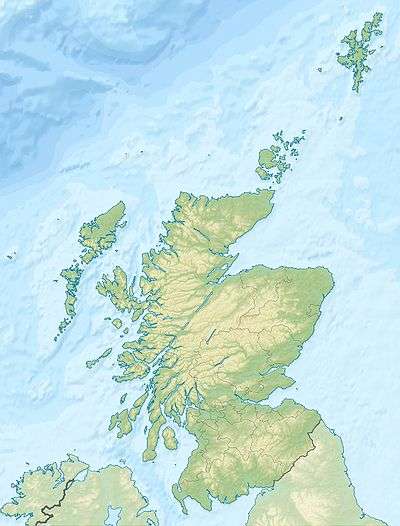Battle of Dalnaspidal
| Battle of Dalnaspidal | |||||||
|---|---|---|---|---|---|---|---|
| Part of Wars of the Three Kingdoms (Scottish Civil War) | |||||||
 Dalnaspidal | |||||||
| |||||||
| Belligerents | |||||||
|
Clan MacGregor Clan Robertson |
Clan Campbell | ||||||
| Commanders and leaders | |||||||
|
|
| ||||||
| Strength | |||||||
| 1,200 foot, 800 horse (cavalry).[1] | Unknown | ||||||
| Casualties and losses | |||||||
| 300 horse captured.[1] | Unknown | ||||||
 Location within Scotland | |||||||
The Battle of Dalnaspidal was a battle during the Wars of the Three Kingdoms and one of the last engagements of the Scottish Civil War, bringing an end to the Royalist rising of 1651 to 1654.
Prelude
The Earl of Glencairn raised the Clan MacGregor from Rannoch. He would have no difficulty recruiting them because one of their opponents was the Earl of Argyll, a Campbell, one of their hereditary enemies. Alexander, the 12th chief of Clan Robertson led his men from Fea Corrie. Both forces met above Annat and marched up the old path to Loch Garry.
Battle
On the evening of 19 July 1654, Thomas Morgan surprised John Middleton, 1st Earl of Middleton at Dalnaspidal near Loch Garry on the Drumochter Pass. The Royalist horse had become separated from the foot. When Morgan's superior forces advanced towards them, most of Middleton's cavalry fled, leaving the infantry unprotected. As Morgan's cavalry continued to advance, the Royalist infantry also turned and ran.[2]
Aftermath
The fight at Dalnaspidal broke the Royalist insurrection in the Highlands. Although wounded, Middleton managed to escape into the mountains, but he was never able to gather a substantial force again.[3] Monck wanted all the leaders of the uprising put to death, but the Protector and Council promised a pardon to all those who submitted. The Earl of Glencairn himself surrendered to General Monck in September 1654. Middleton escaped back to the Continent and rejoined Charles II at Cologne early in 1655.
Noes
- 1 2 Baker 2005, p. 65.
- ↑ Baker 2005, pp. 65–66.
- ↑ Baker 2005, p. 66.
References
- Baker, Helen (August 2005), The Glencairn Uprising, 1653-54 (PDF), Department of Linguistics, Lancaster University for their Newsbooks at Lancaster project.
Further reading
- Plant, David (28 February 2007), Glencairn's Uprising, British Civil Wars and Commonwealth website, retrieved September 2013 Check date values in:
|access-date=(help) - Plant, David (7 December 2009), John Middleton, c.1608-74, British Civil Wars and Commonwealth website, retrieved September 2013 Check date values in:
|access-date=(help)
Coordinates: 56°49′55″N 4°13′23″W / 56.832°N 4.223°W